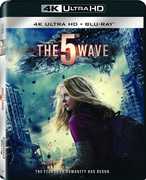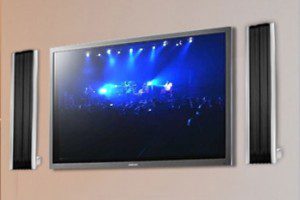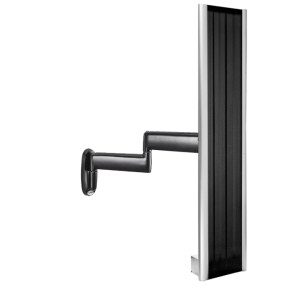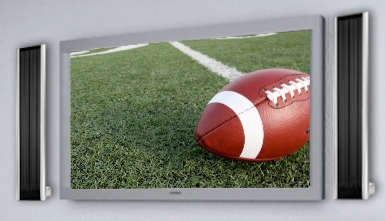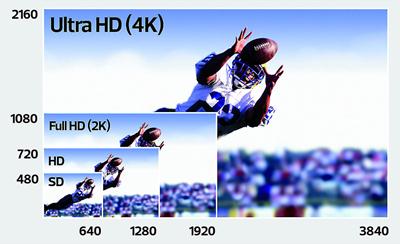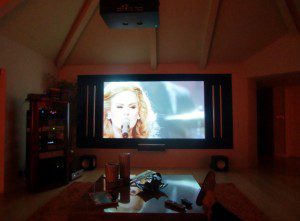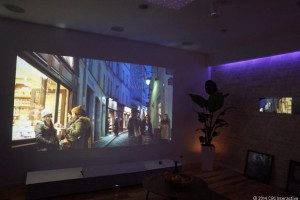
It’s not always easy to choose the right set of headphones. You want them to look nice, sound good, and be sturdy enough that you won’t have to replace them any time soon. The team at House of Marley audio collection specializes in not only standing out, but being consistently made of recyclable materials. Here we’ve provided a roundup, one audio device from each of their product categories.
Smile Jamaica earbuds

My favorite thing about the Smile Jamaica earbuds is how they stand out of the crowd. The buds have a thick fabric-covered braided cord with just enough color to stand out in the packaging. The cable ends with a little rubber stopper in between the cord and the buds. The majority of the buds — certainly the parts that will stick out of your ear — are made from the same FSC-certified mahogany and beech wood found in many acoustic guitars.
The package comes with three different size ear tips, one smaller and one larger than the pair that come attached. Despite being a little bulkier as a result of the thicker cords, the Smile Jamaica buds are comfortable to wear for hours, and after shoving them in pocket after pocket they have yet to tangle up. The Smile Jamaica’s come in three different cable styles, allowing you to have either a straight cable, or a cable with a microphone for mobile devices. The third variant of the cable includes musical controls, but the website warns that it works with iOS-devices only.

The sound generated by the Smile Jamaica earbuds is very clean with a great balance of high pitch noises and handle every king of music I threw at it well. The 8mm moving coil drivers in these earbuds also deliver a surprising bass kick, adding character to most everything you play without being so strong as to try to vibrate out of your head. Unlike many less expensive earbuds, the Smile Jamaica’s maintained their audio quality as it got louder, instead of allowing the sound to become muddy or overly bassy.
House of Marley bills the tips as being “noise isolating”, and while I didn’t find them to be exactly that the earbuds get more than loud enough to drown out most of the world around you, with very little of the sound seeping back out into the world around you. For $30, the Smile Jamaica earbuds are terrific. Not only do they look and feel great, but they deliver more than enough quality sound to make the average mobile music fan happy.
Revolution on-ear headphones

Mid-range on-ear headphones are tricky business. The goal for any company to approach this range is to keep costs as low as possible without losing too much sound quality. The House of Marley Revolution headphones try to fit that mold. The headphones themselves are made of recyclable aluminum and canvas, giving them a light but sturdy feel to them. The headphones have a nice fabric woven cable that comes in either straight cable or microphone and iOS music controller cable. The cable is not removable from the headphones, but the Revolution collapses using a pair of swivel joints just above the headphones, so there’s little to no tress put on the cable when it is placed in storage. Despite being on-ear headphones, the Revolutions do not push on the ears, and so let you wear them for hours without discomfort.
Compared to the rest of the House of Marley audio devices I’ve experienced for this review, the Revolutions are a bit disappointing. While managing to be light and comfortable, the Revolutions are not nearly as clean and crisp as the rest of the House of Marley lineup. Almost everything you listen to with these headphones is very bass heavy, and in cases where the song is meant to be bassy it just comes out muddy. During a phone call or with purely instrumental music, the Revolutions sound much better, but most other things you try to listen to the headphones did not live up to the rest of the brand. For $90, the Revolutions fall into the mid-range trap of failing to balance between decrease in cost and decrease in quality.
Destiny TTR headphones

At CES this year, one of the representatives put a pair of Destiny TTR’s on my head and told me it would be the best audio experience I had ever had. They sounded pretty good, but I was in a room with nearly 5,000 other loud people, so I simply smiled and moved on. When I received a pair to review, I knew that the top of the line at House of Marley was going to need a little more attention.
As the only pair of over-the-ear headphones that House of Marley sells, the TTR’s are by far the largest of their headphones. The head band and ear cups are a soft leather that breathes well enough that your head doesn’t get hot wearing them for long periods of time. The rest of the headphones that you can see is recyclable aluminum, making them feel light and strong. The TTRs come with two different cables and a handful of accessories in the hard case you find inside the packaging. You have a Studio style 52-inch braided straight cable, a much shorter cable with a microphone and phone control built in, and a pair of 3.5mm jack converters. The TTRs are powered headphones, requiring a pair of AAA batteries to drive the headphones. Unfortunately, the headphones don’t work without the batteries so if they die while you are on the go you are stuck until you find some more.

From the moment you put the TTRs on and turn the switch, your head is encompassed in whatever your headphones are plugged into. The sound isolating design of the headphones keeps most sounds out when you aren’t listening to music, and pushed the rest of the sounds out when music starts playing. The sound is incredibly clean, some of the most balanced headphones I have ever enjoyed. The bass sounds like it is farther away than the actual headphones as a result of your ears not resting right against the headphone. Phone calls, instrumental, and heavy bass all sound great with these headphones.
The House of Marley TTR’s are my favorite sounding headphones to date. Many of my colleagues didn’t feel the same way, but that was because they could hear what I was hearing from up to two rooms away. The TTRs do absolutely nothing to keep the sound inside the headphones, you might as well be wearing them backwards there’s so much audio leak. For $300, House of Marley clearly put their best foot forward. These headphones sound amazing, and come with quality accessories that help make them useful in a wide variety of situations. Unless your workspace had a door, or everyone else in your office has headphones on, you’ll probably have to refrain from keeping your skull mounted boom box in the office, but wherever you use them you are sure to enjoy the experience.
And now for something completely different

House of Marley has made quite a name for themselves with high quality audio equipment that not only stands out but is marginally more eco-friendly than most of their competitors. The House of Marley guys also make some home and mobile audio devices, the most recent of which was unveiled at CES this year. The House of Marley Bag of Rhythm is a portable stereo system. Like the boom boxes of yesteryear, the Bag needs six D batteries to function without the power cord. For an eco-friendly company to force users to rely on disposable batteries seemed a little strange, but the team at House of Marley tells of a rechargeable battery pack that will be available “soon”. The bag is designed for an iPhone or iPad to dock into it, but includes an AUX jack for the rest of us.

Out of this torso-sized noise machine with its 4.5-inch woofers and a matching pair of 1-inch tweeters comes plenty of high quality audio. The bag is capable of getting very loud without losing audio quality, and like many of House of Marley’s other products, provides a nice balance of clean sounding audio with just enough bass to compliment. The bag is light enough, and the strap supportive enough, that you could absolutely enjoy walking down the street blasting arrest-worthy volume levels with no problems.
For $350, you’d need a really good reason to convince yourself that you just had to have one of these. I’ll admit that while I enjoyed the audio quality of the Bag of Rhythm, I kept it in my car in the hopes that when I was out somewhere the opportunity would present itself where I’d be able to bust out some tunes and have a good time. If you find yourself spending a lot of time at a park or on the beach where this kind of equipment won’t get you in any trouble, then the Bag or Rhythm would be an incredible addition to your audio arsenal.






![The Martian [4K Ultra HD + Blu-ray + Digital HD] The Martian [4K Ultra HD + Blu-ray + Digital HD]](http://media.aent-m.com/Graphics/Items/sdImages/a/180/1/4/9/4/3294941.jpg)
![The Last Witch Hunter [4K Ultra HD + Blu-ray + Digital HD] , Vin Diesel The Last Witch Hunter [4K Ultra HD + Blu-ray + Digital HD] , Vin Diesel](http://media.aent-m.com/Graphics/Items/sdImages/b/180/4/9/4/2/3082494.jpg)
![Sicario [4K Ultra HD + Blu-ray + Digital HD] , Emily Blunt Sicario [4K Ultra HD + Blu-ray + Digital HD] , Emily Blunt](http://media.aent-m.com/Graphics/Items/sdImages/b/180/5/9/4/2/3082495.jpg)
![Ender’s Game [4K Ultra HD + Blu-ray + Digital HD] Ender’s Game [4K Ultra HD + Blu-ray + Digital HD]](http://media.aent-m.com/Graphics/Items/sdImages/a/180/0/8/5/3/3083580.jpg)
![The Amazing Spider-Man 2 [4K Ultra HD + Blu-ray] The Amazing Spider-Man 2 [4K Ultra HD + Blu-ray]](http://media.aent-m.com/Graphics/Items/sdImages/c/180/7/2/9/4/3294927.jpg)
![Chappie [4K Ultra HD + Blu-ray] Chappie [4K Ultra HD + Blu-ray]](http://media.aent-m.com/Graphics/Items/sdImages/b/180/6/2/9/4/3294926.jpg)

![The Expendables 3 [4K Ultra HD + Blu-ray + Digital HD] , Sylvester Stallone The Expendables 3 [4K Ultra HD + Blu-ray + Digital HD] , Sylvester Stallone](http://media.aent-m.com/Graphics/Items/sdImages/c/180/8/7/5/3/3083578.jpg)
![Salt [4K Ultra HD + Blu-ray] Salt [4K Ultra HD + Blu-ray]](http://media.aent-m.com/Graphics/Items/sdImages/b/180/4/2/9/4/3294924.jpg)
![Hancock [4K Ultra HD + Blu-ray] Hancock [4K Ultra HD + Blu-ray]](http://media.aent-m.com/Graphics/Items/sdImages/b/180/5/2/9/4/3294925.jpg)
![The Smurfs 2 [4K Ultra HD + Blu-ray] , Jonathan Winters The Smurfs 2 [4K Ultra HD + Blu-ray] , Jonathan Winters](http://media.aent-m.com/Graphics/Items/sdImages/c/180/8/2/9/4/3294928.jpg)
![The Pineapple Express [4K Ultra HD + Blu-ray] , Seth Rogen The Pineapple Express [4K Ultra HD + Blu-ray] , Seth Rogen](http://media.aent-m.com/Graphics/Items/sdImages/c/180/9/2/9/4/3294929.jpg)
![Mad Max Fury Road [4K Ultra HD + Blu-ray + Digital HD] Mad Max Fury Road [4K Ultra HD + Blu-ray + Digital HD]](http://media.aent-m.com/Graphics/Items/sdImages/a/180/0/2/9/4/3294920.jpg)
![X-Men Days of Future Past [4K Ultra HD + Blu-ray + Digital HD] X-Men Days of Future Past [4K Ultra HD + Blu-ray + Digital HD]](http://media.aent-m.com/Graphics/Items/sdImages/c/180/9/3/9/4/3294939.jpg)
![Kingsman: The Secret Service [4K Ultra HD + Blu-ray + Digital HD] Kingsman: The Secret Service [4K Ultra HD + Blu-ray + Digital HD]](http://media.aent-m.com/Graphics/Items/sdImages/b/180/5/3/9/4/3294935.jpg)
![The Peanuts Movie [4K Ultra HD + Blu-ray + Digital HD] The Peanuts Movie [4K Ultra HD + Blu-ray + Digital HD]](http://media.aent-m.com/Graphics/Items/sdImages/b/180/4/4/9/4/3294944.jpg)
![Life of Pi [4K Ultra HD + Blu-ray + Digital HD] Life of Pi [4K Ultra HD + Blu-ray + Digital HD]](http://media.aent-m.com/Graphics/Items/sdImages/c/180/7/3/9/4/3294937.jpg)
![San Andreas [4K Ultra HD + Blu-ray + Digital HD] San Andreas [4K Ultra HD + Blu-ray + Digital HD]](http://media.aent-m.com/Graphics/Items/sdImages/b/180/5/4/9/4/3294945.jpg)

![Exodus: Gods and Kings [4K Ultra HD + Blu-ray + Digital HD] Exodus: Gods and Kings [4K Ultra HD + Blu-ray + Digital HD]](http://media.aent-m.com/Graphics/Items/sdImages/b/180/6/3/9/4/3294936.jpg)
![Hitman: Agent 47 [4K Ultra HD + Blu-ray + Digital HD] , Rupert Friend Hitman: Agent 47 [4K Ultra HD + Blu-ray + Digital HD] , Rupert Friend](http://media.aent-m.com/Graphics/Items/sdImages/a/180/0/4/9/4/3294940.jpg)
![Fantastic 4 [4K Ultra HD + Blu-ray + Digital HD] Fantastic 4 [4K Ultra HD + Blu-ray + Digital HD]](http://media.aent-m.com/Graphics/Items/sdImages/a/180/2/4/9/4/3294942.jpg)
![Concussion [4K Ultra HD + Blu-ray] , Will Smith Concussion [4K Ultra HD + Blu-ray] , Will Smith](http://media.aent-m.com/Graphics/Items/sdImages/a/180/3/2/9/4/3294923.jpg)
![The Maze Runner [4K Ultra HD + Blu-ray + Digital HD] The Maze Runner [4K Ultra HD + Blu-ray + Digital HD]](http://media.aent-m.com/Graphics/Items/sdImages/c/180/8/3/9/4/3294938.jpg)
![Pan [4K Ultra HD + Blu-ray + Digital HD] Pan [4K Ultra HD + Blu-ray + Digital HD]](http://media.aent-m.com/Graphics/Items/sdImages/a/180/1/2/9/4/3294921.jpg)
![The Lego Movie [4K Ultra HD + Blu-ray + Digital HD] The Lego Movie [4K Ultra HD + Blu-ray + Digital HD]](http://media.aent-m.com/Graphics/Items/sdImages/c/180/9/1/9/4/3294919.jpg)
![Wild [4K Ultra HD + Blu-ray + Digital HD] , Reese Witherspoon Wild [4K Ultra HD + Blu-ray + Digital HD] , Reese Witherspoon](http://media.aent-m.com/Graphics/Items/sdImages/b/180/4/3/9/4/3294934.jpg)
